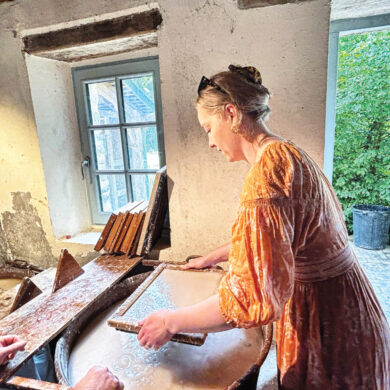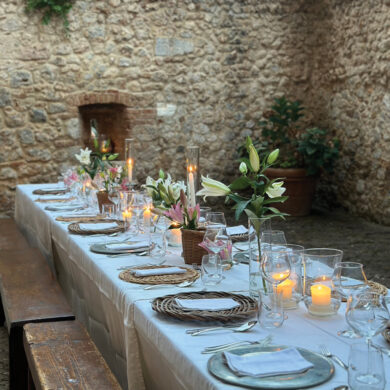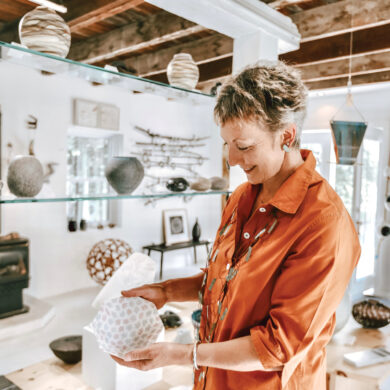
Step into the Skinny laMinx store on Bree Street in Cape Town, South Africa, and you’re instantly transported into my colourful, multi-patterned world.
From the racks of fabrics in our signature shades reminiscent of colours that I associate with a mid-century palette to the range of decor accessories, children’s clothing and tableware on offer, this place perfectly encapsulates the Skinny laMinx aesthetic—playful yet beautifully considered, witty yet thoughtful, bright but not garish. This is the very special realm I have created via my unique take on pattern and colour.
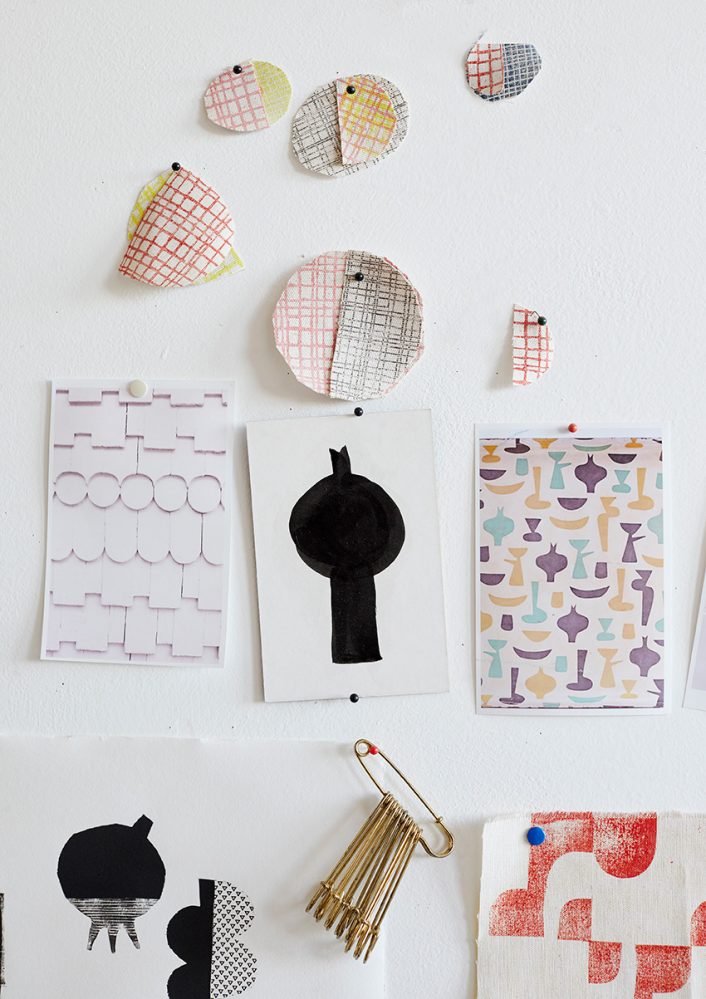
Skinny laMinx is now known across the world: the sales team maintains the brand’s own thriving e-commerce website, and I hosted our first international product range launch in Paris in 2017. And, both brand and store are well known now to all South Africans who take an interest in locally produced designs and products. But of course, this wasn’t always the case.
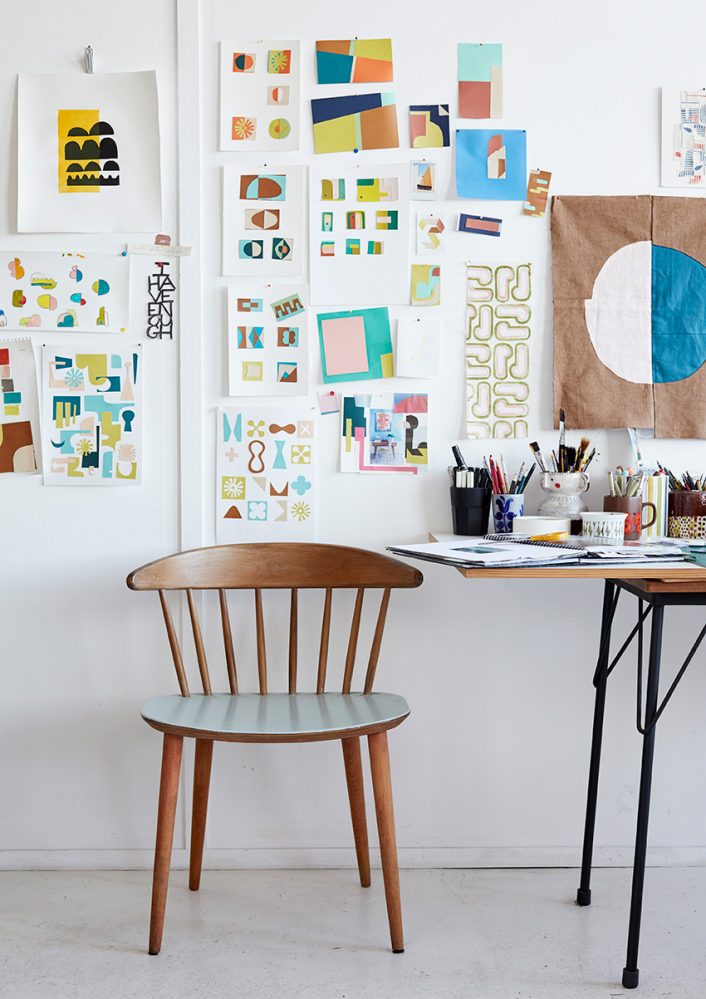
Back in 2006, when I created my Skinny laMinx blog (still active today) and launched my Etsy store selling vinyl cut-outs made into fridge magnets and one-off screen prints, my ‘day job’ was writing for an on-going series of South African comics. But, as a lifelong ‘maker of things’ in general, the arrival of the internet made me very frustrated because I could see into everyone’s studios, where they were making and selling things, and I had such a strong urge to do the same.
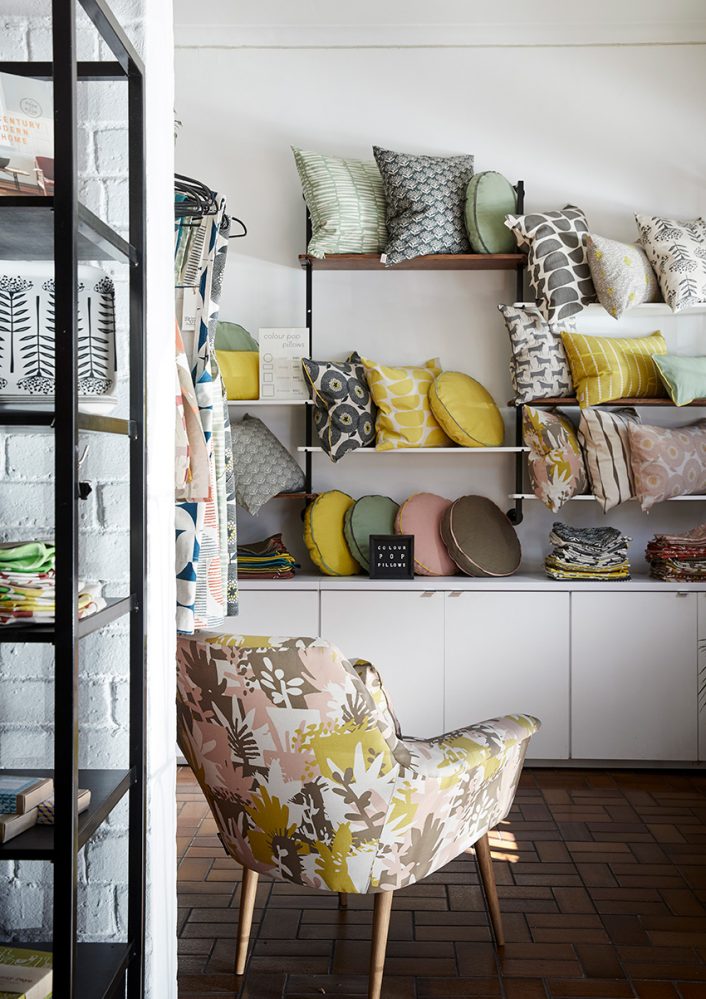
Between 2006 and 2008, I began to focus on creating screen-printed tea towels, which I sold on Saturday mornings at the Neighbourgoods market in Woodstock, Cape Town, South Africa, while also marketed it internationally via my Etsy storefront. Quite quickly, those international orders became regular ones. For example, it was around this time that Heath Ceramics, the globally renowned San Francisco-based creators of handmade ceramic tiles and tableware, placed their first ‘order’, which at first was a ‘let’s swap ceramics for tea towels’ arrangement. (The relationship between the two brands is on-going, with Heath Ceramics now stocking a range of Skinny laMinx tea towels and other goods in their stores, and us having produced a range of fabric designs inspired by their tiles.)
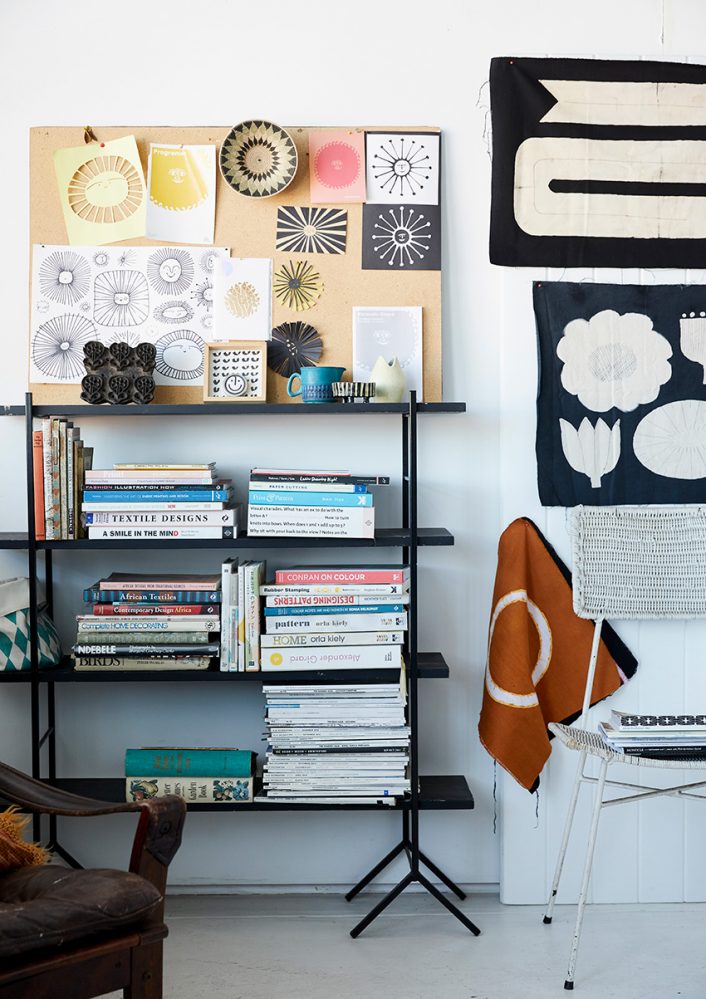
The positive feedback from both local and international customers convinced me I really did have a viable business on my hands, and by 2009 I was able to give up my writing job and devote myself to Skinny laMinx full-time. Still working out of a small-shared studio, I also began to move beyond tea towels into designing fabrics for yardage—a rather different enterprise as it involves working out pattern repetitions across a larger area.
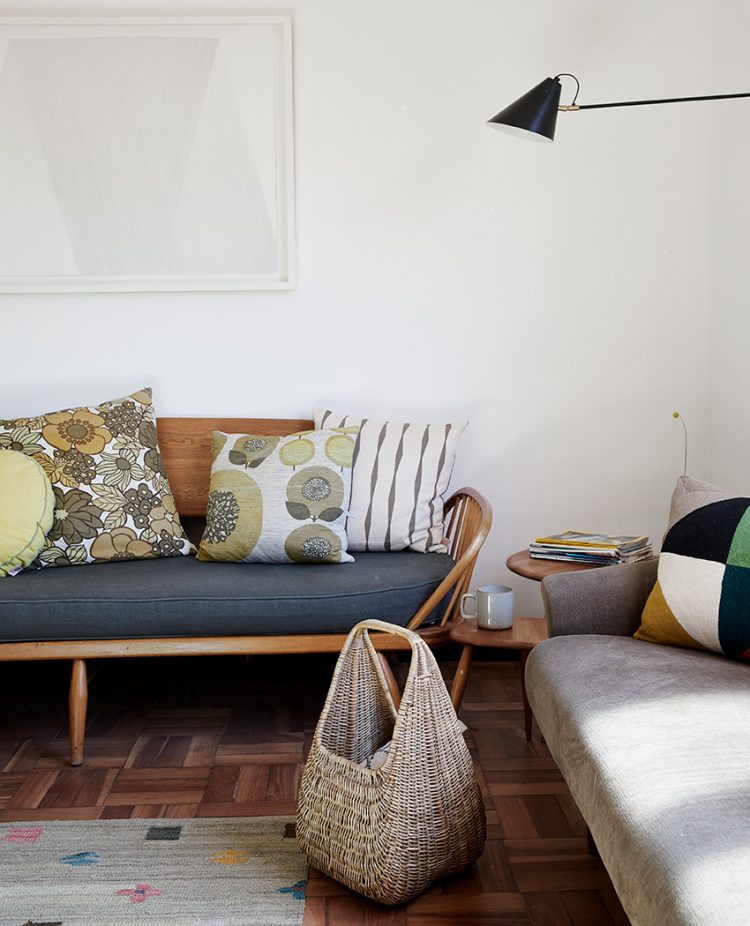
I’m always making things. There’s always something buzzing around in the background of my mind. Whether it’s colour collages or linocuts…just things really. I am currently experimenting with a small tabletop loom with lengths of colourful woven fabric pieces in a variety of stripes and zigzag patterns, all made from scraps of wool.
I’ll probably use these pieces for collaboration with a rug maker soon. It would be a good idea if I understood weaving from the inside out before actually starting to design a full-size rug. This hands-on approach to the design process is essential to the way I create all of my work. It’s why making a paper cut-out of South Africa’s ubiquitous Pincushion protea flower became a fabric called Pincushion (and later, Large Pincushion and Tall Pincushion too). And it’s why working on a group of ceramic objects at my ceramics class also, in time, became a fabric called Oddjects. My experience of traditional block-printing techniques in Jaipur, India, inspired a print called Weft, visual cues from architectural elements, which became repeat patterns called Aperture and Breeze, and Heath Ceramics tiles inspired fabrics that reflect on the visual workings of their shapes (Dimensional Ovals, Dimensional Triangles and Dimensional Diamonds).
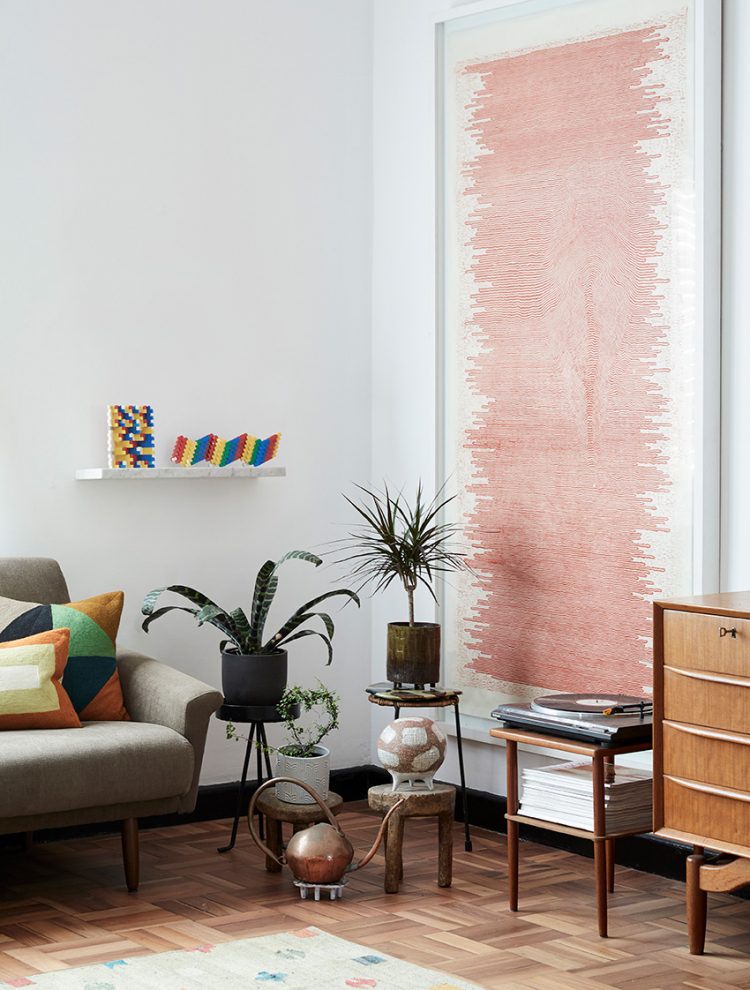
This is also why I repeatedly reference—on both my blog and in person—the importance of ‘Making Friday’. In spite of the demands of running a small business, I almost invariably spend at least one day per week just making things, on my own, in my studio, for long periods, too. I may not know whether the ceramics, paper dolls or chair cut-outs that I’m creating are going to turn into fabric designs—and that very lack of a set ‘design direction’ is precisely what results in genuine creative moments. It just, kind of, gathers itself—continually visually recording and processing turning into a sort of story. This is often expressed via a paper cut-out (rather than a drawing) or block printing using a linocut technique. Then it’s a case of learning to ‘trust your first decision’—and the result might well be the recent Palmetto, Fronds and ZigZag fabrics, which feature stylised leaf shapes, or the Roof Garden range, an homage to the succulent plants that have been able to survive—and thrive—during Cape Town’s current drought.
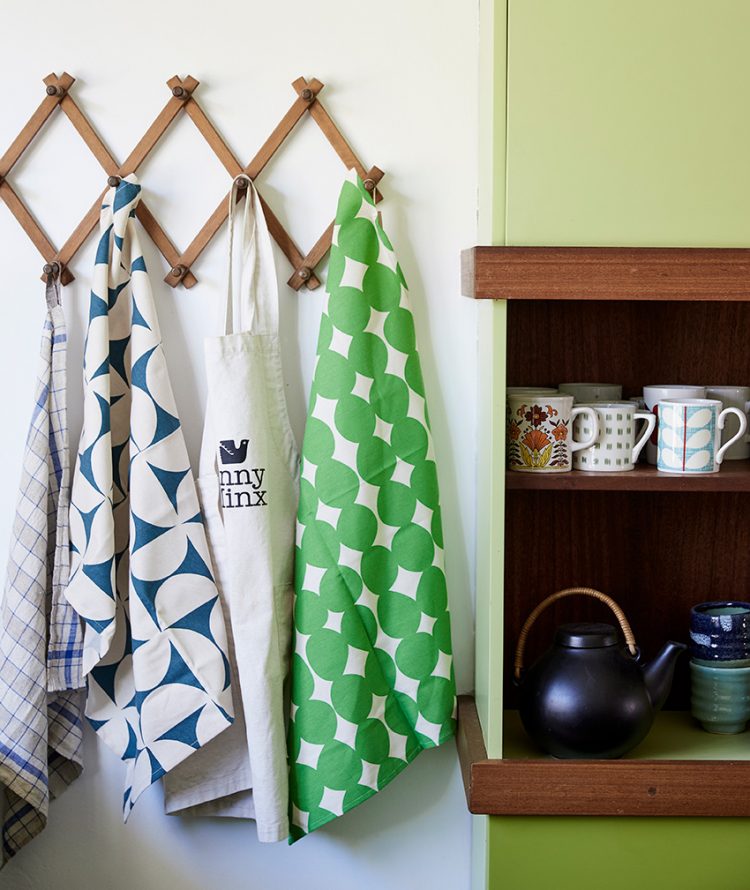
The first Skinny laMinx range of prints produced exclusively for yardage was the Sevilla Rock collection of 2006, which was inspired by South Africa’s world-renowned, ancient Khoisan cave paintings. Of these five designs, one—called Herds and consisting of a repeat-and-reverse pattern made up of an ultra-simple animal silhouette—is still being produced. Available in Black, Deep Red and a chic Hide Grey, it’s a unique and elegant design.
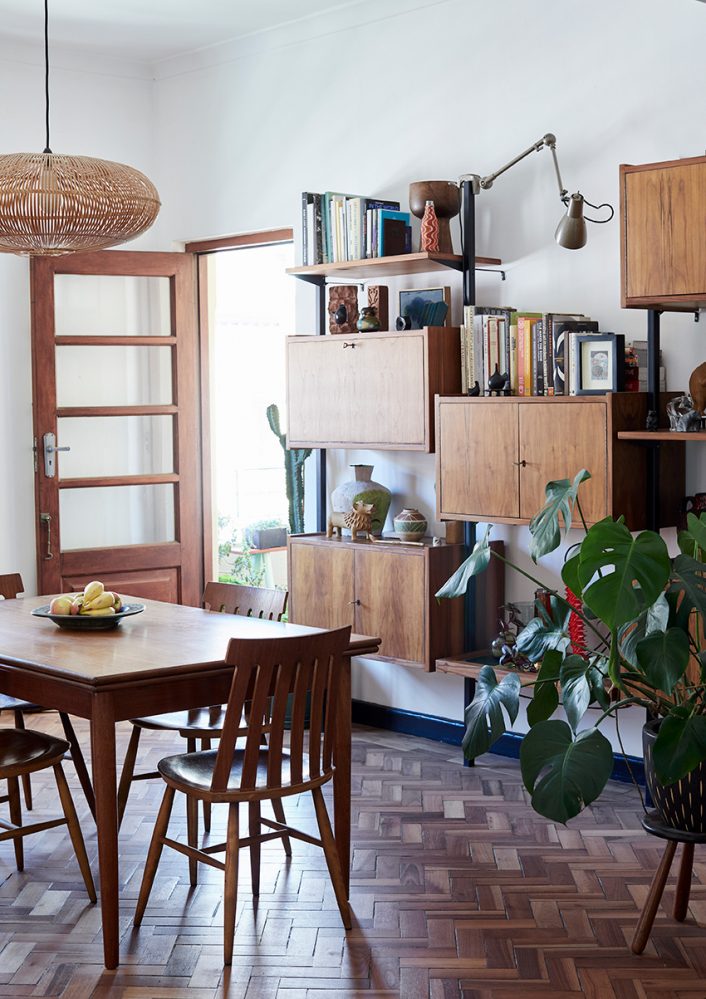
The Skinny laMinx colour palette tends to lean towards the dirtier tones, like petrol blues, olive greens, chartreuse, cocoa and burnt orange, all of which are colours that I associate with a mid-century palette, and all of which work together in interesting ways. I have to confess to a deep hatred of purple—it makes me feel revolting inside when I think about purple fabrics or products, although I do quite love it on flowers and butterflies. In short, my palette and overall aesthetic combine a contemporary sensibility with a subtly retro, mid-century modern feel.
“If you’re trying to see a star in the night sky, you see it better if you look off to one side.”
In terms of the Skinny laMinx brand, that palette has also subtly shifted over the years. I used to have quite a lot of olive green, which I no longer feature, but I have been pretty consistent with colours like chartreuse and grey. Over the last few years, as Skinny laMinx has been growing more of a market with decorators, we’ve tried to fill gaps in our palette. So, when we were choosing colours for our 2016 Brise Soleil collection, we focussed on blues, as we hardly had any in the colour mix. We also find neutrals like charcoals and greys are popular, so often include them as a colourway. When we launched the Roof Garden design, we took the opportunity of making our first three-colour print to create some marvellously wild colour mixes, which was exciting.
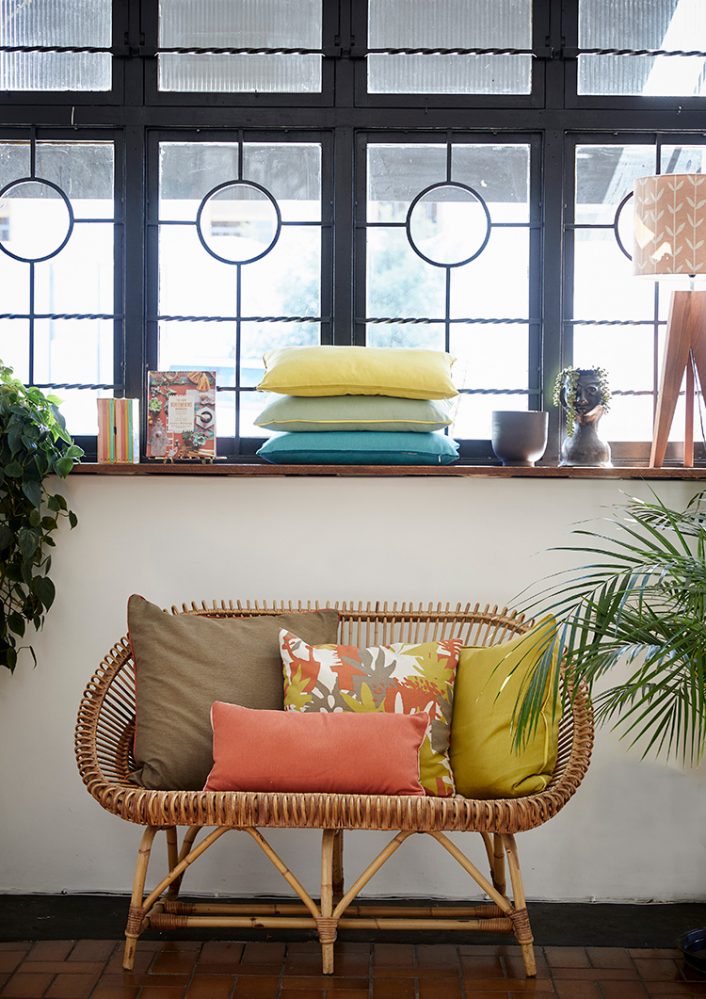
In 2010 Pearl Thompson—now head of business at Skinny laMinx—arrived on the scene. Thompson was working for herself at the time, having left the corporate world, and as she told the Skinny laMinx blog, ‘had the idea of approaching a couple of independent Cape Town-based creatives to see if they needed someone like me to help with the running of their business while they got on with the design side of things’. Soon after she and I had our first meeting, and I offered Thompson a stake in the business. Ever since, Thompson has been the organised, decisive, numbers-driven person in the business.
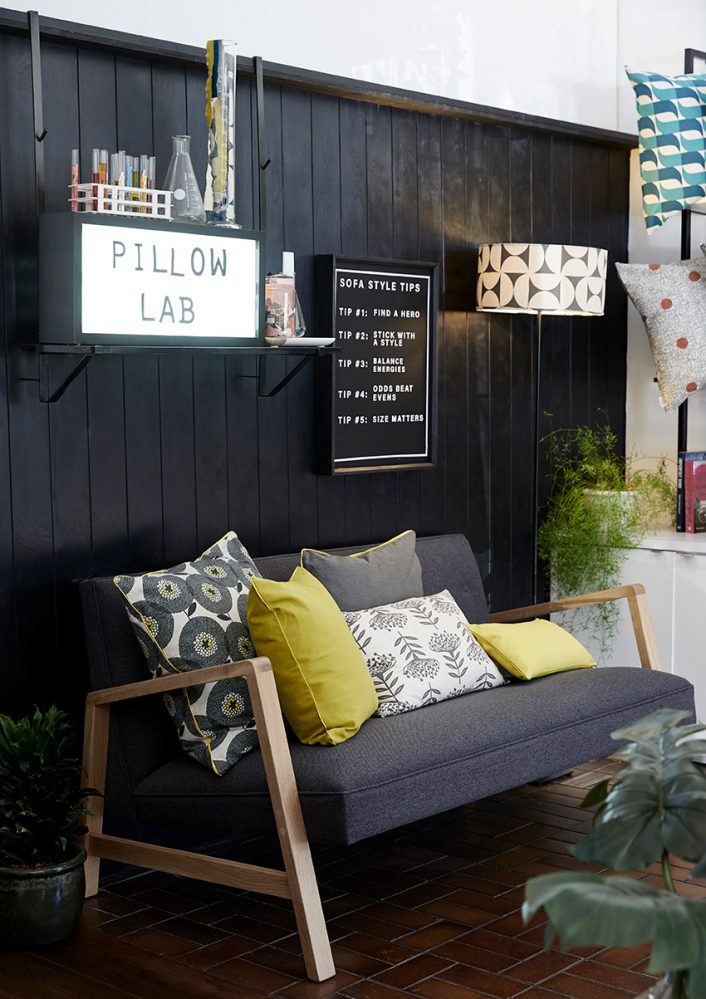
At the end of 2011, the Skinny laMinx shop opened on Bree Street, which at that time was just on the cusp of becoming the hive of creative businesses and foodie enterprises that it is today. In 2017—a very busy year when we also launched the Roof Garden fabric range and travelled to Jaipur in India for a second time with Ace Camps to teach pattern-making workshops—the store was renovated and expanded slightly. I picked out my Bowls print, in bright Persimmon (a vibrant coral shade), as an ever-popular option with customers. Our two top-selling designs are Bowls in persimmon, which is quite a strong choice, or Pincushion, in charcoal, which is very traditional. Our sharp lemon yellow is a consistent seller too, because it mixes so well with so many other colours, adding a burst of energy to greys or sages or blues.
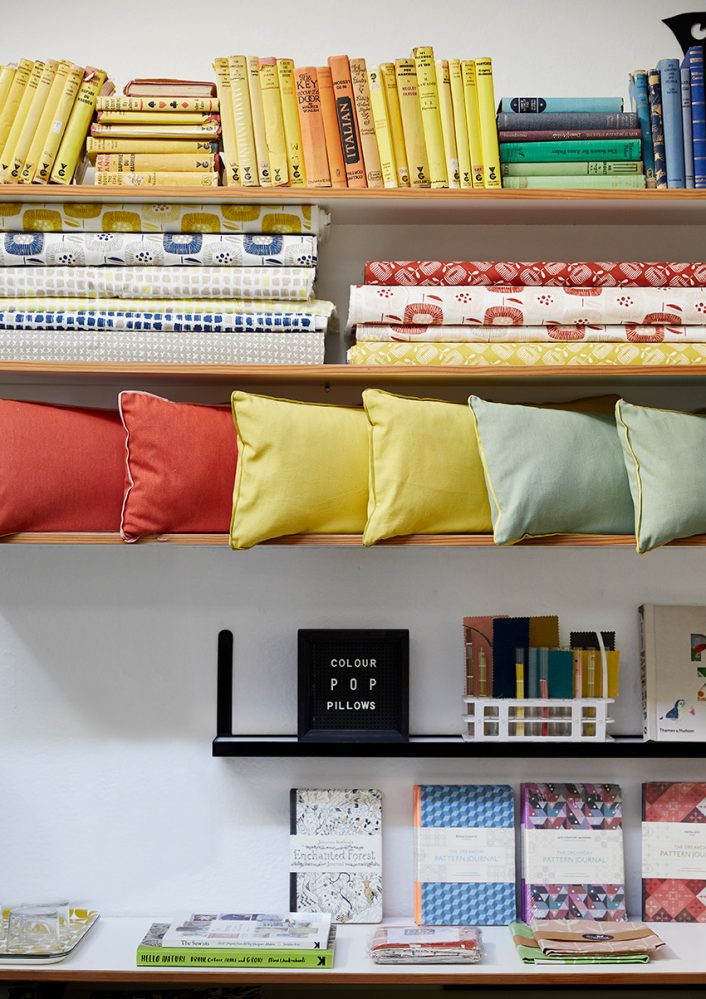
So far in 2018, Skinny laMinx has launched its new ‘Colour Pop’ pillow range—a range of scatter cushions in solid colours that coordinate perfectly with the brand’s patterns. I enjoy a spot of teaching and have run pattern-design workshops in eSwatini (Swaziland) and in Cape Town. My current aim is to go beyond a single ‘Making Friday’ to spending a minimum of three days a week building a strong line in my studio. The results are sure to bring yet more brilliant Skinny laMinx pattern and colour and pattern to homes and interiors around the globe.
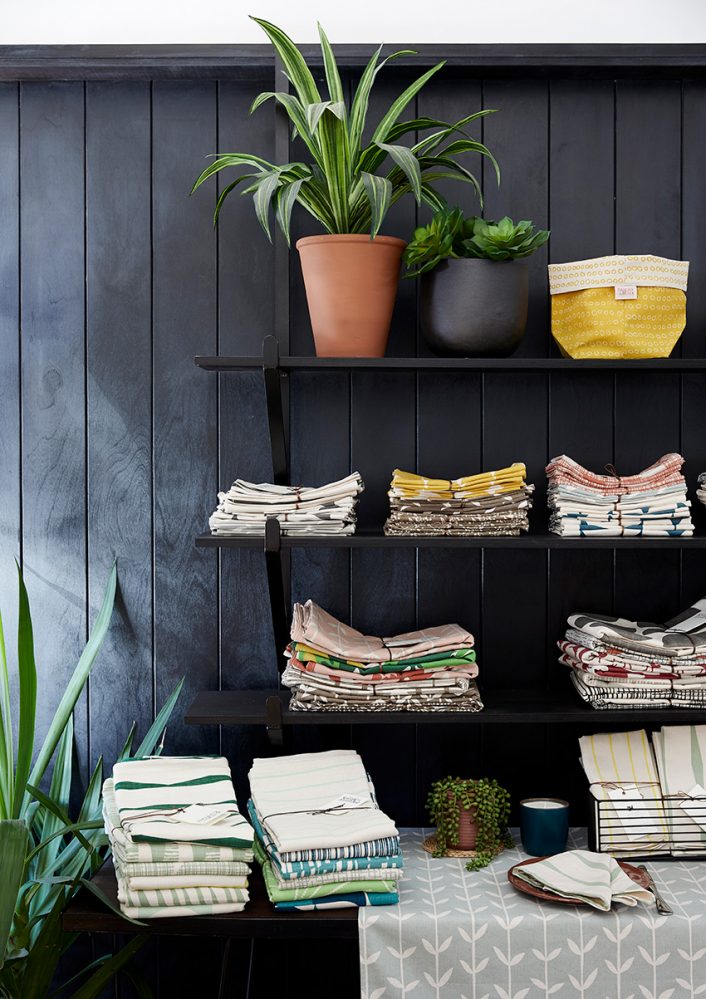

Step into the Skinny laMinx store on Bree Street in Cape Town, South Africa, and you’re instantly transported into my colourful, multi-patterned world.
From the racks of fabrics in our signature shades reminiscent of colours that I associate with a mid-century palette to the range of decor accessories, children’s clothing and tableware on offer, this place perfectly encapsulates the Skinny laMinx aesthetic—playful yet beautifully considered, witty yet thoughtful, bright but not garish. This is the very special realm I have created via my unique take on pattern and colour.

Skinny laMinx is now known across the world: the sales team maintains the brand’s own thriving e-commerce website, and I hosted our first international product range launch in Paris in 2017. And, both brand and store are well known now to all South Africans who take an interest in locally produced designs and products. But of course, this wasn’t always the case.

Back in 2006, when I created my Skinny laMinx blog (still active today) and launched my Etsy store selling vinyl cut-outs made into fridge magnets and one-off screen prints, my ‘day job’ was writing for an on-going series of South African comics. But, as a lifelong ‘maker of things’ in general, the arrival of the internet made me very frustrated because I could see into everyone’s studios, where they were making and selling things, and I had such a strong urge to do the same.

Between 2006 and 2008, I began to focus on creating screen-printed tea towels, which I sold on Saturday mornings at the Neighbourgoods market in Woodstock, Cape Town, South Africa, while also marketed it internationally via my Etsy storefront. Quite quickly, those international orders became regular ones. For example, it was around this time that Heath Ceramics, the globally renowned San Francisco-based creators of handmade ceramic tiles and tableware, placed their first ‘order’, which at first was a ‘let’s swap ceramics for tea towels’ arrangement. (The relationship between the two brands is on-going, with Heath Ceramics now stocking a range of Skinny laMinx tea towels and other goods in their stores, and us having produced a range of fabric designs inspired by their tiles.)

The positive feedback from both local and international customers convinced me I really did have a viable business on my hands, and by 2009 I was able to give up my writing job and devote myself to Skinny laMinx full-time. Still working out of a small-shared studio, I also began to move beyond tea towels into designing fabrics for yardage—a rather different enterprise as it involves working out pattern repetitions across a larger area.

I’m always making things. There’s always something buzzing around in the background of my mind. Whether it’s colour collages or linocuts…just things really. I am currently experimenting with a small tabletop loom with lengths of colourful woven fabric pieces in a variety of stripes and zigzag patterns, all made from scraps of wool.
I’ll probably use these pieces for collaboration with a rug maker soon. It would be a good idea if I understood weaving from the inside out before actually starting to design a full-size rug. This hands-on approach to the design process is essential to the way I create all of my work. It’s why making a paper cut-out of South Africa’s ubiquitous Pincushion protea flower became a fabric called Pincushion (and later, Large Pincushion and Tall Pincushion too). And it’s why working on a group of ceramic objects at my ceramics class also, in time, became a fabric called Oddjects. My experience of traditional block-printing techniques in Jaipur, India, inspired a print called Weft, visual cues from architectural elements, which became repeat patterns called Aperture and Breeze, and Heath Ceramics tiles inspired fabrics that reflect on the visual workings of their shapes (Dimensional Ovals, Dimensional Triangles and Dimensional Diamonds).

This is also why I repeatedly reference—on both my blog and in person—the importance of ‘Making Friday’. In spite of the demands of running a small business, I almost invariably spend at least one day per week just making things, on my own, in my studio, for long periods, too. I may not know whether the ceramics, paper dolls or chair cut-outs that I’m creating are going to turn into fabric designs—and that very lack of a set ‘design direction’ is precisely what results in genuine creative moments. It just, kind of, gathers itself—continually visually recording and processing turning into a sort of story. This is often expressed via a paper cut-out (rather than a drawing) or block printing using a linocut technique. Then it’s a case of learning to ‘trust your first decision’—and the result might well be the recent Palmetto, Fronds and ZigZag fabrics, which feature stylised leaf shapes, or the Roof Garden range, an homage to the succulent plants that have been able to survive—and thrive—during Cape Town’s current drought.

The first Skinny laMinx range of prints produced exclusively for yardage was the Sevilla Rock collection of 2006, which was inspired by South Africa’s world-renowned, ancient Khoisan cave paintings. Of these five designs, one—called Herds and consisting of a repeat-and-reverse pattern made up of an ultra-simple animal silhouette—is still being produced. Available in Black, Deep Red and a chic Hide Grey, it’s a unique and elegant design.

The Skinny laMinx colour palette tends to lean towards the dirtier tones, like petrol blues, olive greens, chartreuse, cocoa and burnt orange, all of which are colours that I associate with a mid-century palette, and all of which work together in interesting ways. I have to confess to a deep hatred of purple—it makes me feel revolting inside when I think about purple fabrics or products, although I do quite love it on flowers and butterflies. In short, my palette and overall aesthetic combine a contemporary sensibility with a subtly retro, mid-century modern feel.
“If you’re trying to see a star in the night sky, you see it better if you look off to one side.”
In terms of the Skinny laMinx brand, that palette has also subtly shifted over the years. I used to have quite a lot of olive green, which I no longer feature, but I have been pretty consistent with colours like chartreuse and grey. Over the last few years, as Skinny laMinx has been growing more of a market with decorators, we’ve tried to fill gaps in our palette. So, when we were choosing colours for our 2016 Brise Soleil collection, we focussed on blues, as we hardly had any in the colour mix. We also find neutrals like charcoals and greys are popular, so often include them as a colourway. When we launched the Roof Garden design, we took the opportunity of making our first three-colour print to create some marvellously wild colour mixes, which was exciting.

In 2010 Pearl Thompson—now head of business at Skinny laMinx—arrived on the scene. Thompson was working for herself at the time, having left the corporate world, and as she told the Skinny laMinx blog, ‘had the idea of approaching a couple of independent Cape Town-based creatives to see if they needed someone like me to help with the running of their business while they got on with the design side of things’. Soon after she and I had our first meeting, and I offered Thompson a stake in the business. Ever since, Thompson has been the organised, decisive, numbers-driven person in the business.

At the end of 2011, the Skinny laMinx shop opened on Bree Street, which at that time was just on the cusp of becoming the hive of creative businesses and foodie enterprises that it is today. In 2017—a very busy year when we also launched the Roof Garden fabric range and travelled to Jaipur in India for a second time with Ace Camps to teach pattern-making workshops—the store was renovated and expanded slightly. I picked out my Bowls print, in bright Persimmon (a vibrant coral shade), as an ever-popular option with customers. Our two top-selling designs are Bowls in persimmon, which is quite a strong choice, or Pincushion, in charcoal, which is very traditional. Our sharp lemon yellow is a consistent seller too, because it mixes so well with so many other colours, adding a burst of energy to greys or sages or blues.

So far in 2018, Skinny laMinx has launched its new ‘Colour Pop’ pillow range—a range of scatter cushions in solid colours that coordinate perfectly with the brand’s patterns. I enjoy a spot of teaching and have run pattern-design workshops in eSwatini (Swaziland) and in Cape Town. My current aim is to go beyond a single ‘Making Friday’ to spending a minimum of three days a week building a strong line in my studio. The results are sure to bring yet more brilliant Skinny laMinx pattern and colour and pattern to homes and interiors around the globe.















